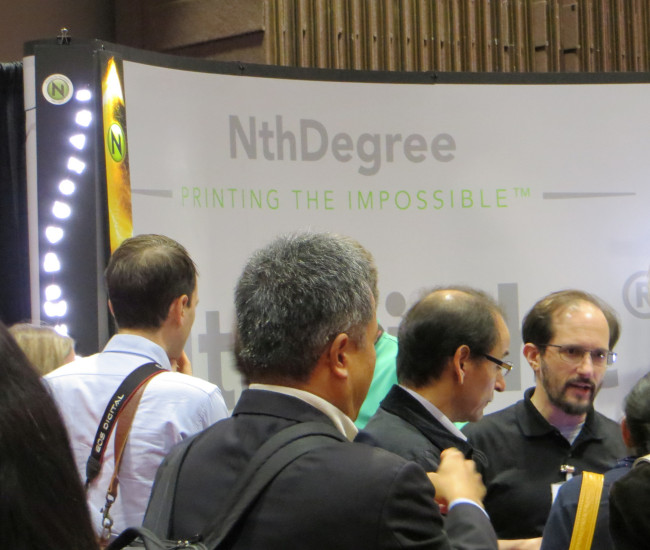The 2015 Printed Electronics Conference (Santa Clara, CA, November 17-20) included a session on “Opportunities in the Lighting Industry“. The session primarily addressed OLEDs although Osram also addressed inorganic LED lighting and presented on Integrating Printed Electronics in the Lighting Industry. Also, in an infrequent trade show appearance, NthDegree Technologies exhibited its printed inorganic LEDs on flexible substrates on the exhibit floor.
In his presentation, Adam Scotch, R&D Manager Osram Sylvania, noted that the growing solid state lighting industry faces several issues including limited industry infrastructure, materials issues particularly related to substrates, as well as competitive products. Scotch noted that OLEDs have, for some time, been thought to be the future of lighting. However, he noted that OLEDs still appear to be 10 years away with many shortfalls, among them cost, lifetime, efficiency and brightness. Scotch also noted that, in many instances, the competition to solid state lighting is still the T8 fluorescent lamp.
In relation to manufacturing infrastructure, Scotch noted that displacing T8 tubes requires placing 420,000 LEDs per hour, in linear form, which means an extremely high production rate requirement. He also noted that picking and placing LEDs in 2D areal form is even harder. For example, Osram, in its present work, uses standard surface mount manufacturing equipment which is limited to handling a 20″ x 20″ inch (51cm x 51cm) panel which is not ideal for the manufacture of 2′ x 2′ (60cm x 60cm) or 2′ x 4′ (60cm x 120cm) typical ceiling luminaires.
To date, Osram has produced 12″ x 12″ (30cm x 30cm) LED sheets which produce 3500 lumen output but these high output sheets produced excessive glare. Therefore, they have also produced the same size sheets delivering 1100 lumens. Osram has proposed making 2′ x 4′ (60cm x 120cm) “troffers” but such large units cannot be readily manufactured using current manufacturing equipment. Osram has also produced linear strips of LEDs on PET strips using etched conductors.
Issues with these strip LEDs include reliability, performance, ESD protection and the strips also present connector issues. Osram uses PET rather than higher temperature Kapton materials owing to cost restrictions. The reliability issues included adhesion, electric resistance variations, silver migration in humidity testing by dendritic growth leading to shorts, and also silver tarnishing. Resistance variation causes brightness variation from luminaire to luminaire. Osram has investigated conductor printing using printing followed by up-plating. Scotch sees the greatest opportunity for printed electronics in lighting applications to be to embed electronic functions in the printed substrate, particularly ESD protection. In general, Dr. Scotch’s talk was a frank and realistic look at the potential for printed electronics in lighting applications and was a timely update on development opportunities.
NthDegree Technologies hosted a very well visited booth (photo below) in the Printed Electronics 2015 exhibit. In November 2015, I wrote a Display Daily article (Exploring the Potential for Printed LEDs) covering NthDegree’s printed flexible LED technology. Since writing that article, I observe that the NthDegree website has been updated considerably to reflect their recent product development progress.
 Source: Phil Wright photo
Source: Phil Wright photo
While visiting the NthDegree booth at Printed Electronics 2015, I spoke with the firm’s CEO Neil Shotton. Neil informed me that they are currently reaching out and working with additional product development partners and generating a good deal of interest in their printed LED lighting. With a tradeshow appearance earlier this fall at SEMA 2015 as well as an upcoming exhibit planned for CES 2016, NthDegree is making an effort to bring its printed LED product to market.
CEO Shotton said he was very engaged with his tradeshow efforts through CES 2016, but said he would provide me the opportunity for a full interview after the annual Consumer Electronics Show. There has been a good deal of technical interest in NthDegree’s printed LED technology as is perhaps hinted at in the tag line in the NthDegree booth display photo above that states, “Printing the Impossible.” I look forward to hearing and writing more about the firm’s printed LED technology and upcoming plans in the new year. – Phil Wright

